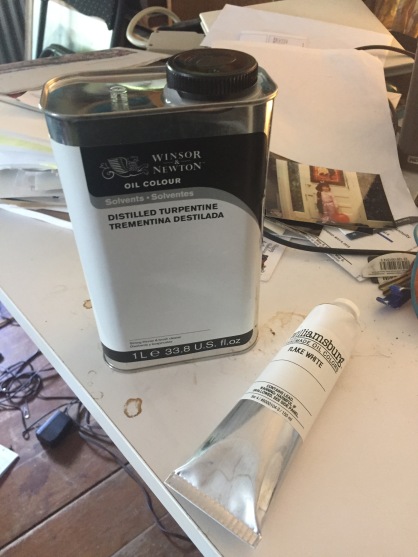Eighty Dollars Worth of Art Supplies
June 14, 2018
There it is. I was at the art store the other day to buy turpentine. THEY WERE OUT OF TURPENTINE. This was not Michael’s, this was Jerry’s Art-a-Rama, a reputable supply chain. The guy apologized to me and said someone had been in a few days earlier and cleaned them out; he then tried to sell me Gamsol. Out of forlorn hope I asked him about Flake White and he had some extremely overpriced small tubes which I didn’t buy (this just came in the mail). That got me started on the subject of metallic pigments and their relative toxicity. I said why worry about lead when cadmium and chrome are just as bad and he wordlessly pointed at a sign hung above the paint section: Winsor Newton is phasing cadmium colors and replacing them with Azo pigments.
I was at the art store the other day to buy turpentine. THEY WERE OUT OF TURPENTINE. This was not Michael’s, this was Jerry’s Art-a-Rama, a reputable supply chain. The guy apologized to me and said someone had been in a few days earlier and cleaned them out; he then tried to sell me Gamsol. Out of forlorn hope I asked him about Flake White and he had some extremely overpriced small tubes which I didn’t buy (this just came in the mail). That got me started on the subject of metallic pigments and their relative toxicity. I said why worry about lead when cadmium and chrome are just as bad and he wordlessly pointed at a sign hung above the paint section: Winsor Newton is phasing cadmium colors and replacing them with Azo pigments.
It’s all the fault of the fucking namby-pamby Europeans. Stop trying to make my hobby safe! Are you going to restrict welders to using sparklers? Can sculptors now only work in styrofoam? And the same message to artists who are wrapped up in safety issues: if you feel obliged to wear a respirator and rubber gloves to paint in oils, DON’T PAINT IN OILS. MY access to potentially hazardous materials does not affect YOUR ability to avoid them. Stop trying to police my materials!
Grr.